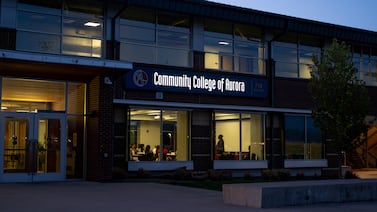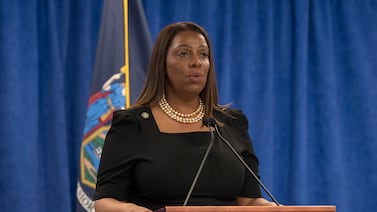There is a child care center across the street from Davine Licon’s home in the northern suburbs of Denver.
The problem is, it only has a spot for her preschool son, not her baby boy Azarius, and Licon can’t start her paid home health internship until she’s lined up full-time care for both children. The single mother has been on four child care waitlists for months.
Versions of Licon’s story play out every day in Colorado and the nation as families grapple with child care shortages exacerbated by the pandemic and now, a tight labor market that makes it hard to hire child care workers. For some parents, the dearth of care — particularly for infants and toddlers — can mean turning down job offers, reducing work hours, and losing income. Others end up sewing their own safety nets by pressing friends and relatives into service, arrangements that can be inconsistent and not always ideal for young children.
Kamarea Garduno used to shuffle her daughter Alaina, now 2, between the homes of her mother, her grandma, and her boyfriend’s father so Garduno could report to her job as a social worker at Parkview Medical Center in Pueblo.
“I tried to alternate because I didn’t want to burn anybody out,” she said.
When snow storms were forecast, she worried about driving the 40 miles to Colorado Springs, where her mother lives. Sometimes, they exchanged Alaina just off the highway exit near her mother’s home.
Groups that help Colorado families find child care say the pandemic has made things harder than ever.
Elizabeth Nevarez, who supervises Mile High United Way’s 2-1-1 phone line, said 48% of parents who’ve called the statewide number this year for help finding child care have eventually succeeded in their searches. She said while infant and toddler care was hard to find even before the pandemic, families now struggle to find care for older children, too.
In addition to drawing up a list of local child care options based on parents’ criteria, the child care navigators at Mile High United Way also offer to place calls on behalf of parents to ask if providers have spots available. More parents have begun using that service this year, Nevarez said.
Paula Arellano, who assists parents looking for child care at Pueblo’s early childhood council, said many call center workers or other employees with non-traditional hours need evening and weekend child care, but that’s the hardest kind to find.
She estimated that 75% of families who call her seeking child care eventually find something, though they sometimes encounter long waitlists and other roadblocks.
“When I do a referral, I may have a parent come back to me two or three times,” she said. “It’s very tough. We don’t have enough providers.”
Garduno eventually found a child care spot for 2-year-old Alaina with help from Arellano — and after a dozen phone calls. Although she was initially leery about going with a home-based provider because of previous bad experiences, things are going well. The provider is helping with Alaina’s potty training and offers Garduno flexible scheduling where she can.
Colorado’s pool of licensed child care providers has been shrinking for years and despite an influx of federal and state COVID relief money over the past year, with more set to flow in the coming months, many continue to struggle as never before. In some cases, they’ve closed entire classrooms or reduced class sizes because they don’t have enough employees to accommodate their usual numbers. Empty slots mean lost income.
Michelle Dalbotten, who co-owns Step by Step Child Development Center in Northglenn, said she’s lately been forced to turn away up to five families a day.
“It’s killing me,” she said. “It’s killing me more because I have the space, I don’t have the staff.”
Step by Step could take 136 children if it had a full complement of 22 employees, but only about 80 youngsters are enrolled right now. Lead teachers at the center make $14 to $18 an hour.
Dalbotten said in her more than 30 years as a child care provider she’s never before had to turn families away because of staff shortages. She posts help wanted ads several times a week on multiple job sites, but has so few applicants she’s lucky to interview one candidate every three to four months.
While filling jobs was often hard before COVID hit, “The pandemic definitely crippled it,” Dalbotten said.
Licon, who may soon get into Step by Step, about 3 miles from her home, is planning her next move. Once she completes her three-month internship, she could potentially get a full-time job, which would allow her to exit a government aid program for low-income families.
“I’m trying to get off of it and just the whole child care thing is difficult for me because I don’t really have family help,” she said.
In the bid to help desperate parents, some child care providers have sought “hardship waivers” exempting them from certain state regulations.
Tammy Hayashi, who cares for up to eight children in her licensed home-based child care business in Brighton, is in the process of seeking a hardship waiver that would allow her to care for three children under age 2 instead of just two. The mother of the baby who would get that third spot works nights as a nurse and needs time to sleep during the day, Hayashi said.
That mother, like other parents who would benefit from a waiver, wrote a letter describing her needs to the state. She explained that she and her husband need two incomes to pay their bills and without the spot at Hayashi’s home, she might have to cut her hours.
Another mother, staying at a homeless shelter in the western Colorado town of Olathe, pleaded her case for the same waiver in a neat hand-written letter to state officials last spring.
“I have a lot riding on this job and if I lose it, I lose everything!” she wrote.







